

Home
About Us
Allotments
Garden Equipment
Seed Suppliers
Manure Problems
Solve It - Puzzles
Children's Pages
GLA Blog
Weather Blog
School Veg Patch
Useful Links
Weather Blog
Garden Video Blog
Controlling Garden Pests
** This website is not a shop and doesn’t sell anything! **
Be aware that any external links may contain cookies and you should refer to the particular website's cookie policy
There are many flying, crawling or walking creatures trying to thwart you by treating your garden as a fast food outlet. The best we can hope for is to control our unwanted visitors and to create and maintain a balance in which we can all exist fairly harmoniously. Note the key word here is control as no amount of effort will totally eliminate garden pests.
One way favoured by some gardeners is to resort to chemical sprays and potions in an attempt to eradicate insect pests. One big disadvantage of this is that this method not only kills the garden pests but also the beneficial insects. Not all insects are bad, just think of, bees, butterflies and ladybirds for example. Who doesn’t like to see these in their gardens except maybe the white butterflies that make our brassicas quiver in fear?
Luckily for us and the wildlife that cause no harm there are alternatives to resorting chemical cocktails.
Encourage biodiversity
Make wildlife your ally. Many creatures are insect or minibeast eaters and will be only too willing to help you control the creatures that ‘prey’ upon your plants. Read this article to find out how to encourage beneficial wildlife into your garden.
Hand Picking and Water Spraying
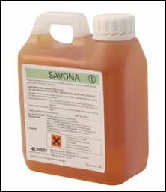 If you are vigilant you may be able to keep the upper hand by removing the pests by picking or rubbing pests off your plants or in the case of slugs carrying out after dark collections.
If you are vigilant you may be able to keep the upper hand by removing the pests by picking or rubbing pests off your plants or in the case of slugs carrying out after dark collections.
Spraying with jets of water can also remove aphids. You can mix up a mild solution of horticultural soft soap to control aphids, brassica whitefly and cabbage white caterpillars.
Biological Control
An increasing number of garden pests can be targeted by the use of natural predators or parasites. The biological control species is introduced artificially. Some of these predators are only effective when released into an enclosed environment such as a greenhouse. Nematodes which infect creatures such as slugs are applied to the soil.
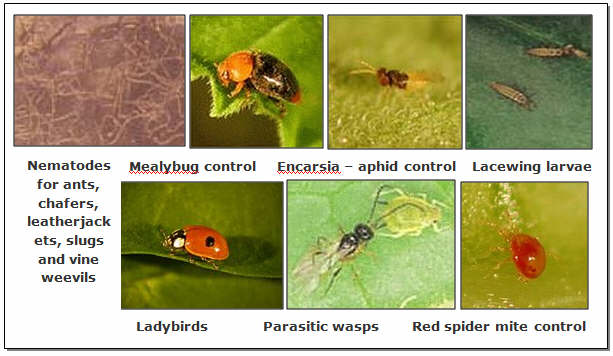
Harrod Horticultural are one company that offer biological control solutions
Barriers
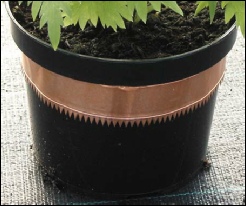 Some pests can be kept at bay by placing deterrent barriers around your plants. If we plant hostas in our garden they are devastated by slugs and snails some use a band of copper tape around pots but to be honest we haven't found this to be very effective
Some pests can be kept at bay by placing deterrent barriers around your plants. If we plant hostas in our garden they are devastated by slugs and snails some use a band of copper tape around pots but to be honest we haven't found this to be very effective
We also place the pots in saucers of water. The pots are raised from the water on some sort of support so they don’t become waterlogged but the slugs need to swim to reach the pots. If pots are placed so that the leaves touch other plants though the slugs or snails will find a way across.
Another method we use is to apply a product called Slug Gone around the plants.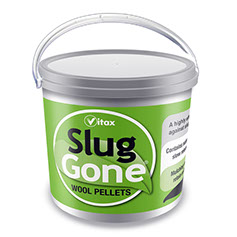 This is effective but rather expensive to use in the open garden.
This is effective but rather expensive to use in the open garden.
See more information on deterring slugs on this page.
On the allotment plot we grow our carrots under enviromesh. You can use fleece but this is less study. We cover our brassicas with insect netting. For information on plant covering click here.
We use glue banding to give fruit trees some protection from winter moths - click here for more information about how we protect our fruit trees.
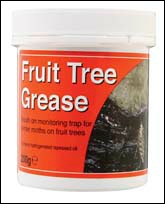

It is easier to just reapply grease in subsequent years and also grease can be used directly on areas where to apply glue banding is impractical. Application is very messy - at least it is when I do it- so I use an old rubber glove to smear the grease onto the tree bark and throw the glove away after use.
Traps and Lures
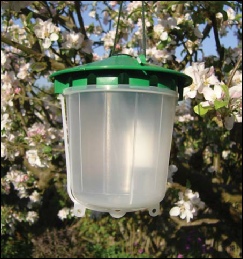 No doubt everyone has heard of the beet traps that many people swear by to lure slugs to a drunken death.
No doubt everyone has heard of the beet traps that many people swear by to lure slugs to a drunken death.
We also use lure traps to protect our apple trees - a container containing a lure impregnated with female pheromones is used to lure codling male moths into a trap. The trapped moths are unable to mate and consequently cut down on the number grubs produced by the females. There are lots of different pests that can be controlled using lures.
To view a selection see Harrod Horticultural.
Many companies suggest that lures are used in conjunction with a spraying regime but we have just used the lures alone and this has given some protection.
Pieces of yellow sticky card can be hung in the greenhouse but these do tend to be indiscriminate and trap beneficial insects as well as pests.
If small mammals are a problem there is also a range of humane traps and tree guards available.
I’ve gathered together some links from companies offering gardening products for sale. I have no connection to the suppliers and therefore cannot be held responsible for any changes in items available or any issues that may arise when making a purchase.
Some companies give me a small commission on sales that are generated from this website which helps me to maintain this and sister websites but this in no way means that I am recommending purchases from a particular company.
Our Plot at Green Lane Allotments Blog | A Gardener's Weather Diary | School Vegetable Patch Website
© Our Plot on Green Lane Allotments - Please email me if you wish to use any of this site's content